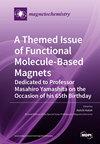β-环糊精纳米海绵稳定磁铁矿/金核壳纳米粒子的合成与表征
IF 2.5
4区 化学
Q2 CHEMISTRY, INORGANIC & NUCLEAR
引用次数: 0
摘要
磁铁矿/金核壳纳米粒子(磁铁矿/金NPs)具有重要的光学和磁性能,具有潜在的应用潜力,特别是在生物医学领域。然而,它们的制备也不能避免可能导致意外或不希望的结构的困难。本文报道了利用四甲基氢氧化铵(TMAH)促进磁铁矿核和薄金壳之间形成连续界面的磁铁矿/金NPs的合成和表征。利用透射电子显微镜(TEM)、能谱(EDS)、场发射扫描电子显微镜(FE-SEM)、ζ-电位、振动样品磁强计(VSM)、选择区域电子衍射(SAED)、紫外可见光谱和动态光散射(DLS)对合成的磁铁矿/金NPs进行了表征,证实了NPs具有窄尺寸分布的核壳结构,同时证明了其等离子体和超顺磁性能。此外,将磁铁矿/金NPs与β-环糊精纳米海绵(β-CDNSs)结合并稳定,获得了一种多功能磁等离子体系统,在药物的包封和控释方面具有潜在的应用前景。本文章由计算机程序翻译,如有差异,请以英文原文为准。
Synthesis and Characterization of Magnetite/Gold Core Shell Nanoparticles Stabilized with a β-Cyclodextrin Nanosponge to Develop a Magneto-Plasmonic System
Magnetite/gold core-shell nanoparticles (magnetite/gold NPs) have important optical and magnetic properties that provide potential for applications, especially biomedical ones. However, their preparation is not exempt from difficulties that might lead to unexpected or undesired structures. This work reports the synthesis and characterization of magnetite/gold NPs using tetramethylammonium hydroxide (TMAH) to promote the formation of a continuous interface between the magnetite core and the thin gold shell. The synthesized magnetite/gold NPs were characterized using transmission electron microscopy (TEM), energy-dispersive spectroscopy (EDS), field emission scanning electron microscope (FE-SEM), ζ-potential, vibrating sample magnetometer (VSM), selected area electron diffraction (SAED), UV-Visible spectroscopy, and dynamic light scattering (DLS), confirming the core-shell structure of the NPs with narrow size distribution while evidencing its plasmonic and superparamagnetic properties as well. Further, the magnetite/gold NPs were associated and stabilized with a β-cyclodextrin nanosponge (β-CDNSs), obtaining a versatile magneto-plasmonic system for potential applications in the encapsulation and controlled release of drugs.
求助全文
通过发布文献求助,成功后即可免费获取论文全文。
去求助
来源期刊

Magnetochemistry
Chemistry-Chemistry (miscellaneous)
CiteScore
3.90
自引率
11.10%
发文量
145
审稿时长
11 weeks
期刊介绍:
Magnetochemistry (ISSN 2312-7481) is a unique international, scientific open access journal on molecular magnetism, the relationship between chemical structure and magnetism and magnetic materials. Magnetochemistry publishes research articles, short communications and reviews. Our aim is to encourage scientists to publish their experimental and theoretical results in as much detail as possible. Therefore, there is no restriction on the length of the papers. The full experimental details must be provided so that the results can be reproduced.
 求助内容:
求助内容: 应助结果提醒方式:
应助结果提醒方式:


